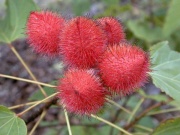Difference between revisions of "Achiote"
Jump to navigation
Jump to search
| (One intermediate revision by one other user not shown) | |||
| Line 8: | Line 8: | ||
''Bixa orellana; annatto; achiote (Esp.); achiote seed; achiotl; lipstick tree; urucum (Tupi)'' | ''Bixa orellana; annatto; achiote (Esp.); achiote seed; achiotl; lipstick tree; urucum (Tupi)'' | ||
| − | == | + | == Risks == |
Color is not permanent. | Color is not permanent. | ||
| − | == | + | ==Resources and Citations== |
| − | |||
| − | |||
| − | |||
| − | |||
* ''Fairchild's Dictionary of Textiles'', Phyllis G.Tortora, Robert S. Merkel (eds.), Fairchild Publications, New York City, 7th edition, 1996 | * ''Fairchild's Dictionary of Textiles'', Phyllis G.Tortora, Robert S. Merkel (eds.), Fairchild Publications, New York City, 7th edition, 1996 | ||
Latest revision as of 16:00, 19 April 2022
Description
Red colorant extracted from the bright colored seed pods of the achiote plant, Bixa orellana, native to Central and South America. Achiote, also called Annatto, gives bright orange color to cotton and a pale pink color to silk. It is sometimes added to yellow dyes to provide a deeper color. Achiote has been used for paints on ethnographic objects (Florian, et al., 1990). It was also used as a textile and skin dye.
Synonyms and Related Terms
Bixa orellana; annatto; achiote (Esp.); achiote seed; achiotl; lipstick tree; urucum (Tupi)
Risks
Color is not permanent.
Resources and Citations
- Fairchild's Dictionary of Textiles, Phyllis G.Tortora, Robert S. Merkel (eds.), Fairchild Publications, New York City, 7th edition, 1996
- Mary-Lou Florian, Dale Paul Kronkright, Ruth E. Norton, The Conservation of Artifacts Made from Plant Materials, The Getty Conservation Institute, Los Angeles, 1990
